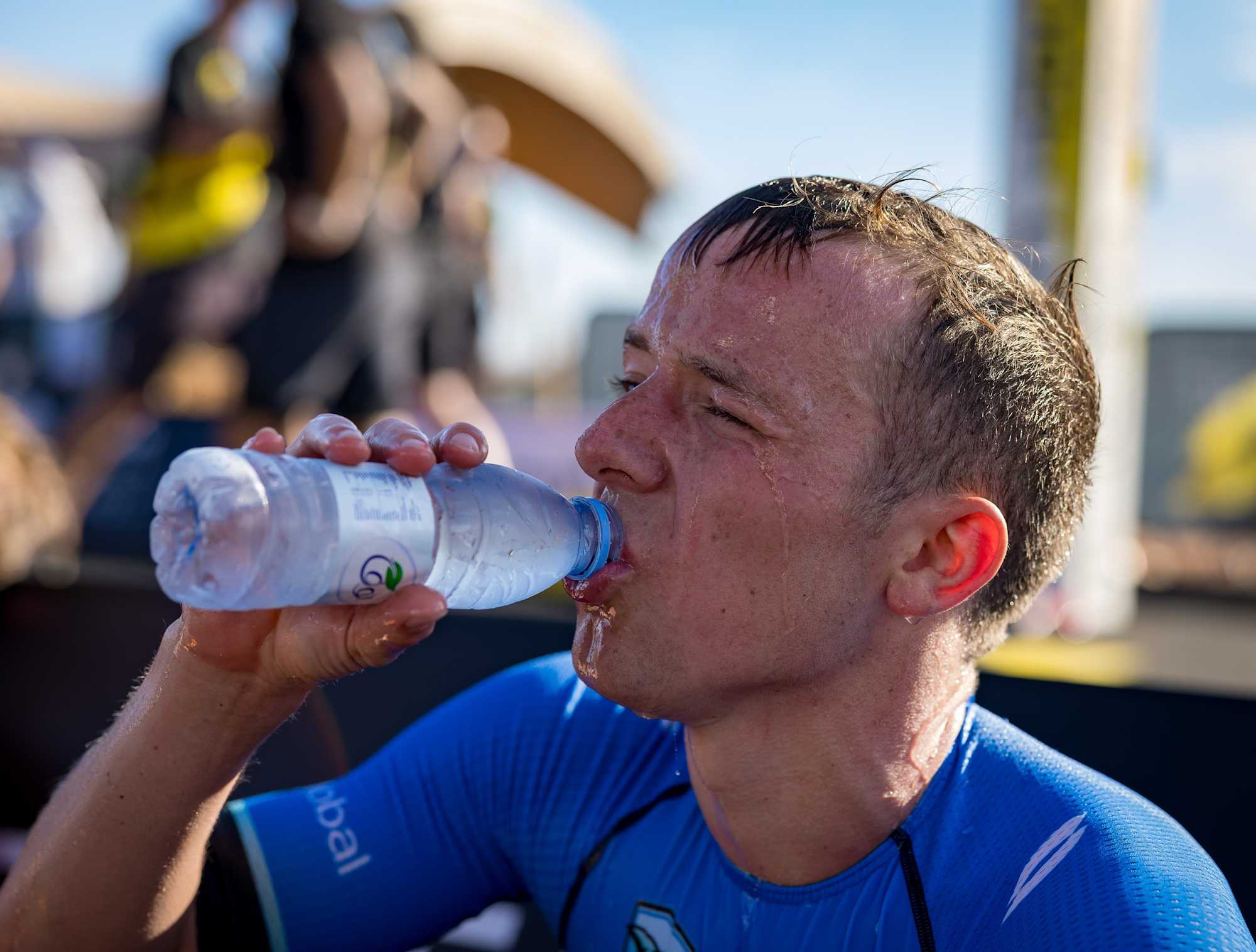Hydration and triathlon: all you need to know for health and performance

Water is critical to just about every bodily function. What’s more we are losing it all the time, from when we sweat to cool down, to the simple act of breathing out moisture droplets every time we exhale.
Water loss increases with exercise. We all have different sweat rates, and factors such as the intensity and duration of exercise and environmental conditions play a role in water loss too. However, athletes can typically expect lose as much as a litre or two of fluid per hour.
If we don’t top up, we become dehydrated. This can detrimentally affect athletic performance and, if it persists, our general health too. We may feel more fatigued if we’re dehydrated, experience reduced muscle function, and struggle to control our body temperature too.
HOW MUCH WATER SHOULD YOU DRINK A DAY?
Drinking water every day is important. However, we shouldn’t get too hung up on quantities. We already have an inbuilt system to tell us when we need to drink, that is called thirst.
We also take on far more water in our daily lives than we probably realise. Water is not only consumed when we drink, it constitutes a large part of our food too. For example, an apple is around 86% water content, and let’s not even start on cucumber…
While acknowledging it varies between individuals, opinion is still divided among experts on precisely how much water you should drink every day. One common recommendation from health experts however, is around 2 litres or half a gallon per day.
WHAT ARE THE SIGNS OF DEHYDRATION?
Thankfully, it’s not difficult to tell if you’re dehydrated in most cases. The first symptom to look for is one we’ve already discussed above, thirst. If you feel you need to quench your thirst you’re likely on the way to becoming dehydrated.
It is worth noting that a persistent feeling of thirst – known as polydipsia – may also be a symptom of an underlying condition. If you’re concerned, book an appointment with your GP to check it out.
Checking the colour of your urine is also a useful guide. If you have dark yellow and strong-smelling pee, rather than light, straw-coloured urine, it can be a sign of dehydration.
Other symptoms of dehydration include feeling tired, dizzy or lightheaded, having a dry mouth, lips and eyes, and peeing fewer than four times a day.
WHAT INCREASES THE CHANCES OF DEHYDRATION?
Dehydration is often caused by excessive exercise, either duration or intensity, combined with not replenishing your system adequately.
While intensity normal results in heavier sweating as the body works to cool itself, it may be harder to spot dehydration through duration. For example, on a four-hour bike ride on a cool day when you don’t feel the need to drink
There are other conditions that can also cause dehydration. These include:
Sun or heat stroke.
Excessive alcohol consumption.
Vomiting and/ or diarrhoea.
Medications that have a diuretic effect (meaning you pee more).
A medical condition, such as diabetes.
CAN YOU DRINK TOO MUCH WATER?
Yes. While most of the time if we take on too much fluid we’ll simply just fill our bladder and eventually pee it out, drinking too much water during sporting events can lead to a condition called hyponatremia. This, in extreme cases, can be fatal.
The fluids in our bodies are a delicate balance of water and electrolytes. If we drink too much water we dilute the concentration of sodium in our blood.
Our cells then begin to swell which can cause health problems, from mild to life-threatening conditions. If sodium gets to abnormally low levels it is called hyponatremia. A condition where we have effectively waterlogged our system.
Symptoms can include a loss of energy, headaches and confusion. More seriously, it can cause spasms and cramps and eventually a seizure or coma. In a critical situation an intravenous electrolyte solution and medication may be required.
To avoid hyponatremia, it is important not to just drink copious amounts of water on endurance events, but also listen to your body. You can also eat food or drink sports drinks that contain minerals such as potassium and sodium.
HOW DOES DEHYDRATION AFFECT TRIATHLON PERFORMANCE?
Dehydration has a variety of effects on the body that can cause decline in sports performance.
These include a reduction in blood volume, decreased blood flow to the skin and decreased sweat rate, meaning an increased core temperature and an increased rate of muscle glycogen use. In summary, because the volume and flow of blood around the body is diminished, the muscles are having to work harder to continue the same level of activity.
Dehydration doesn’t only affect physical application, but can also impact mental performance. This is because it leads to slower reaction times, poor concentration and increased fatigue.
It’s estimated that athletes shouldn’t lose more than 2% of body mass through dehydration to retain levels of performance. This will also enable adequate recovery for the next session, event or match. That said, elite marathon runners have been found to lose up to 4.6% of body mass through dehydration over the course of a race.
HOW SHOULD YOU HYDRATE FOR TRIATHLON?
Hydrating correctly for your optimal sporting performance can be split into three stages: before, during and after exercise.
HYDRATING BEFORE EXERCISE
There are few excuses for failing to hydrate properly before you exercise, especially in hot conditions.
Drink steadily and not excessively in the 24 hours ahead of your event. The colour of your urine should give you a guide as to whether you are properly hydrated.
It’s suggested to drink around 450ml of fluid in the two to four hours before you exercise, although that will differ between individuals, and depending on how much you have consumed prior to this point.
HYDRATING DURING EXERCISE
Drinking during exercise, particularly exercise that goes beyond 45min-1hr or is conducted in a hot environment, is recommended and will probably feel quite natural. Any duration less than that, and most individuals can happily rehydrate at the end of the session.
How much you need to drink will depend on your sweat rate, intensity and duration of exercise and the environment. Larger athletes tend to sweat more than smaller ones, and men typically sweat more than women. Fitter athletes may also sweat more and earlier because their bodies’ cooling processes work efficiently. Drinking little and often rather than a lot at any given time is also likely to be more tolerable to the gut.
HYDRATING AFTER EXERCISE
Drinking after exercise will restore your fluid levels and help your muscles recover. Again, observing the colour of your urine is a good guide to when you are rehydrated. Remember, it should be a light, straw colour.
If you are going to drink alcohol after exercise, be mindful that it is a diuretic. It will give a signal to your kidneys to pee more often. This means you could become more dehydrated, so it’s a good idea to complement alcohol with drinking water. This will also slow down your pace of drinking alcohol and be kinder to your system. For more information on the affects of alcohol on triathlon performance, see our dedicated article here.
HOW CAN I CALCULATE HOW MUCH I NEED TO HYDRATE?
You can listen to your body and react to signs of thirst, but if you want to get more scientific you can also do a sweat rate calculation to determine whether you’re a light or heavy sweater, which will inform how much you need to rehydrate.
To perform a sweat rate calculation weigh yourself before and after exercise, then for every kilogram of body weight you lose, drink up to a litre and a half of fluid.
If you want to be more accurate still you can also turn to a specialist sports hydration company such as Precision Hydration that will analyse both the sweat rate and sodium content of the sweat to understand both fluid and electrolyte loss.
WHAT ARE ELECTROLYTES AND WHY ARE THEY IMPORTANT FOR TRIATHLON HYDRATION?
When we sweat we don’t only lose water but salts and minerals such as potassium and sodium. These are typically replaced when we eat foods so in everyday life we don’t have to be overly concerned. In fact, we’re often more worried with our westernised diets of having too much salt in our food.
However, during a long endurance event such as a triathlon race, replacing electrolytes can be critical. As well as the carbohydrates for energy, this is why you see some sports drinks advertising electrolytes in their ingredients. Electrolytes do not have to come from specialist drinks, they could also be from salt tabs or other types of nutrition such as gels or chews or even specific hydration tablets.
DO I NEED TO DRINK A SPORTS DRINK DURING EXERCISE?
For the majority of sporting events water will usually suffice. But there are advantages to having sports drinks. As well as rehydrating, They provide sugars in the form of sucrose, glucose and fructose to give you energy, and minerals to replace electrolytes. In essence, they tick all the boxes, particularly for endurance athletes who’ll be exercising for longer durations.
DO I NEED TO DRINK SPORTS DRINKS FOR TRIATHLON?
This is a topic of debate among nutritionists, not only for triathlon hydration, but for hydrating for sport in general. Many argue a sports drink can provide an added boost to performance, while others suggest the stated benefits are more of a marketing hype.
There are a multitude of sports drinks available that will help you rehydrate, provide energy in the form of sugars that can quickly be broken down and used, and top up your electrolytes such sodium, potassium and magnesium.
The longer the sporting event, the more likely you are to need to refuel. A specialist sports drink can achieve this, but other carbohydrate-rich foods or drinks can also suffice.
Those arguing against sports drinks do so because of the extra sugar content and often a belief that an athlete is better to train to become more fat-adapted to enable the body to use ample fat stores as energy. It is countered by the view that activity at a higher intensity requires carbohydrate which needs replenishing after 90mins to 2hours of exercise and only carbohydrates will suffice. So for longer and more intense forms of exercise, such as triathlon, hydration using sports drinks might be a good idea.
FAQS
HOW DO YOU MAKE YOUR OWN SPORTS HYDRATION DRINK?
It’s not difficult to make your own sports drink. One of the easiest ways is simply to add a pinch of salt to a 1 litre of diluted-to-drink squash. You can adjust the quantities to taste.
WHAT DOES THE URINE COLOUR CHART FROM THE NHS MEAN?
The urine colour chart can provide an estimate of how dehydrated you are by simply judging the colour of your pee against the shades on the chart. Urine will typically be darker first thing in the morning, as the body becomes a little dehydrated overnight. It naturally carries a yellow pigment, so should be a light yellow or close-to-clear colour when you are fully hydrated. If you’re becoming dehydrated, you’ll notice that your urine is becoming a deep amber or even light brown.
WHAT ARE HYDRATION TABLETS?
Also known as electrolyte tablets, hydration tablets contain elements such as sodium and potassium that your body needs to remain hydrated. The minerals aid in the absorption of sodium through the wall of the intestine. Hydration tablets often contain more electrolytes and a lot less or no sugar than formulated sports drinks. They are typically taken in capsule form or dissolved in water.
WILL BEING DEHYDRATED GIVE YOU A HEADACHE?
Yes, a headache can be a symptom of dehydration. Other symptoms include excessive thirst, a dry mouth and feeling dizzy.
WHAT IS A HYDRATION VEST?
A hydration vest is a specially designed running accessory similar to a backpack that will also contain a reservoir or bladder commonly made of rubber or flexible plastic. Fluid can be stored in this and consumed through a long straw the athlete grabs. The vest may also have various other pouches for storing things such as nutrition, lightweight rain jackets and even car keys. It will have adjustable straps to distribute the weight and make it sit as comfortably as possible, ideal for endurance events when initial minor irritations such as chafing can grow into bigger issues.
WHAT IS A HYDRATION BLADDER?
A hydration bladder or reservoir is a means to carry fluid on the move in as efficient a manner as possible. Hydration bladders typically have long straws so the athlete can rehydrate easily on the move and can be refilled quickly at aid stations or checkpoints without wasting much time or effort.







